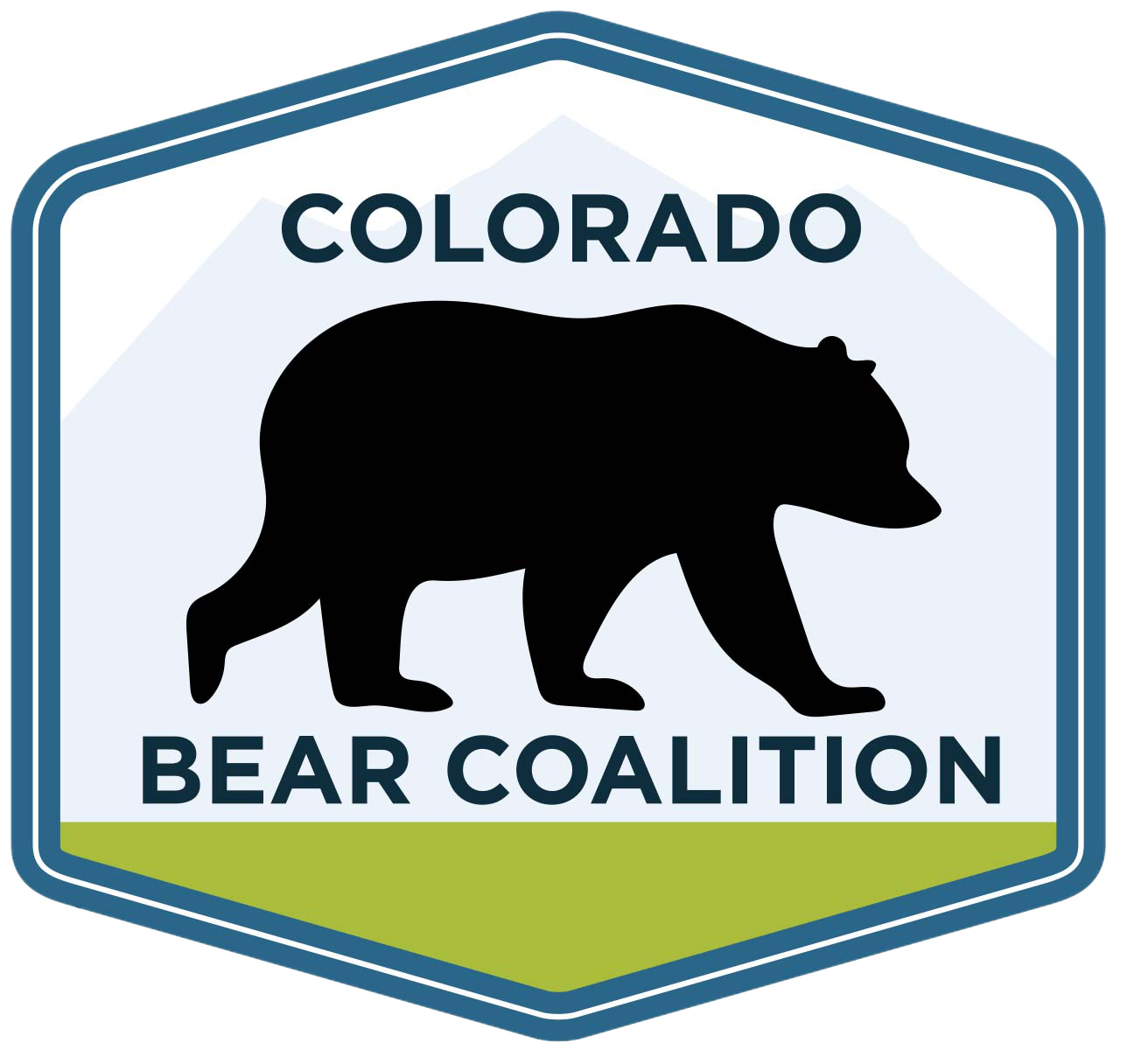
Our Work
Ways We Put Ideas Into Action
-
Fruit Gleaning Program
-

Native Food Buffer Zone
-

Student Team Sponsor
-

Stakeholder Meetings
-

Trash Ordinance
-

Trash Enforcement
-

Community Outreach
-

Research and Human Behavior
-

Electric Fencing Program
Our Community Bear Guide gives communities the tools they need to take a lead role in reducing human-bear conflict in their community.
Putting decades of experience to work so local citizens and organizations don’t have to reinvent the wheel.
Our Guiding Principles
Our work is organized around
three main strategies
-
Keeping bears out of town before they get into trouble.
Our mission and our programs all hinge on the need to proactively prevent bears from coming into urban environments. Reactionary measures will never achieve our compassionate mission. Rather, we think ahead, look ahead, and work ahead for the greater good of bears and people.
Colorado Parks and Wildlife (CPW) is responsible for responding to bears that are in town. Based on the bear’s history, current activity and location, the wildlife officer will decide to either leave the bear alone, tranquilize and relocate or euthanize the bear. By the time a bear is already in town, its chance of survival is severely reduced.
Rather than responding to a bear that is already in town, taking a proactive approach is the best way of keeping bears safe.
There are clear actions that communities can take to keep bears from coming into town, and to deter those that do come through town.
Reduce Attractants-Secure trash -Harvest fruit trees -Remove bird feeders -Protect livestock and beehives-Minimize water sources
Increase Deterrents-Use of electric fencing to protect livestock, beehives and homes -Increase hazing of bears when safe to do so
-
To protect bears across Colorado, it is essential that community members work with city officials and state wildlife managers to establish shared goals and strategies. Without collaboration between stakeholders there is misunderstandings, division and mistrust. Working together creates opportunities for the community and city to take responsible steps to keep bears out of town and to decrease the need for CPW’s handling of bears in town.
Identifying stakeholders:
Community Role of community is to identify and reduce attractants in town, increase deterrents so bears are not comfortable in town, and advocate for policy that protects bears.
City and/or County Officials Role of the city/county is to set and enforce policy, keep the community safe, and respond to community values.
CPW Role of state wildlife managers is to keep people safe from wild animals and to handle wildlife as needed.
Stakeholder Working Group Role of stakeholder working group (formed by representatives from the community, city/county and state) is to meet periodically, brainstorm and implement ways to keep bears out of urban areas.
Network of Bear Groups Role of network of bear groups is to build strong infrastructure across the state/nation to protect bears.
-
With an ever expanding human footprint, bears are facing interactions with humans more than ever before. With this changing landscape, we need to respond with new ways of protecting bears. Solutions that work in one city may also work in another, thus the importance of sharing solutions and networking ideas across our state.
We know the power of thinking outside the box to develop new and effective approaches for keeping bears out of town. We believe the problem doesn’t have to be overly expensive or troublesome to solve—with smart thinking and creative problem-solving, the solutions are accessible and even inspiring.
Why and How
WHY WE DO THIS WORK
The lives of bears matter.
Someone has to speak up for them -to represent their voice at the table of policy decisions and community dialogue over how to live with bears; how to keep our communities safe while also protecting the lives of bears.
Bears are killed for just being bears.
Hundreds of bears are killed every year across Colorado due to human negligence. Bears are in town because they are hungry and because they find easy calories. Bears are opportunists. Bears know the trash schedule!
We have the tools to keep them safe. We can do better.
We are not victims to state or local policy.
We can make the change we want to see.
We do this work because we care deeply about Colorado’s black bears and the communities that share their landscape. Many bear-related tragedies can be prevented through better coordination, communication, and accountability at the community level. These efforts aren’t about vilifying anyone or any agency or demanding perfection—they’re about improving systems, fostering understanding, and ensuring every bear’s death teaches us something that helps prevent the next.
HOW WE WORK
We are problem-solvers, getting to the root of the cause of the problem. We don’t get hung up on how frustrating it can be to make change. We are dot connectors. Bears are in town. Residents have bird feeders, chickens and unsecured trash. Rather than focus on the officer who handles the bears, we focus on why the bear is in town having to be handled. It’s a trash management (and other attractant) problem, not a bear problem.
We care more about achieving the goal - reducing lethal management of bears due to human-bear conflict -than on who gets the credit. We work with all stakeholders, despite different viewpoints. Sometimes collaboration means providing vision and well thought out solutions to those who have the power to make change. And then we step aside and support their efforts to get the job done.
We are respectful of others. No shaming, no blaming. Period.
We are a stickler for integrity, honesty, and will always uphold professional etiquette. If not, we make changes within our organization as we will tolerate nothing less. Our approach is not rooted in blame or division, but in partnership and shared responsibility, one that builds bridges rather than barriers.We work collaboratively, as this is key to success. We strive to share knowledge and ideas with humility and respect, recognizing that everyone brings different experiences and perspectives to the table. Our goal is to listen carefully, offer solutions, and be part of the problem-solving process, not to demand action or tell others what to do. We see this as an ongoing dialogue, where we work together to find the best path forward. By finding common ground, each takes a responsibility for the outcome, thus providing a much stronger outcome.
We are solution focused. We do our homework to understand the problem and provide thoughtful, innovative solutions.
We respect independent thought and open dialogue. We have a willingness to engage in respectful debate (in fact this can be the impetus to real innovation). We avoid assumptions and practice empathy and listen to understand.
We work within systems to create practical long-term change. It is a systemic problem thus needs to be addressed as such. It is no one entity, agency, community’s fault. We have to work together to solve the problem and to adapt to changing landscapes (e.g. bears figure out the bear resistant cans, climate change effecting hibernation)
Our mission remains clear: to reduce human–bear conflict through cooperation, accountability, and community action grounded in compassion and respect. Together, we can make Colorado a safer place for both people and bears.
Colorado Bear Coalition’s mission is not to condemn but to collaborate, to bridge gaps between agencies, local governments, and communities to prevent unnecessary bear deaths and improve coexistence strategies.
A Vision for Colorado’s Future
The Colorado Bear Coalition is working to build:
Bear-safe communities that reduce conflict through infrastructure and education
Stronger partnerships with municipalities, HOAs, and state agencies
A statewide trash management model that protects wildlife
Community-level training, resources, and best practices
Long-lasting systems that prevent conflict and support healthy ecosystems
FUTURE WORK
CBC will continue to champion constructive initiatives, such as a statewide process improvement feedback loop to evaluate bear-handling incidents—not to assign fault, but to identify systemic gaps and ensure lessons lead to improvement and strengthen community-level responses.
On-going Areas of Focus
Pitkin County Landfill
Dozens of Bears, Decades of Activity
Pitkin County Landfill
Timeline
Local News More bears are dining at the county dump. Aspen Daily News, Sep 7, 2023
”Pitkin County Solid Waste Director Cathy Hall said landfill staff have been counting about 30 regular bears eating trash and compost at the landfill in the last two summers. In previous years, she said, they numbered around 15 to 20.”Stakeholder Meeting CBC organizes an on-site meeting with stakeholder to brainstorm ways to reduce bears at the landfill. Meeting Summary. November 11, 2023
Local News County considers fences to keep ‘super bears’ out of dump. Aspen Daily News, Feb 14, 2024
“I’ve always heard ‘Don’t feed the bear’ and if we’re feeding them and they’re becoming super bears because they’re getting all this nutrition and they’re having more cubs, it seems like we’re just putting off a problem that’s going to keep getting worse,” Poschman said. “Nobody likes the thought of euthanizing bears and I don’t know if that’s the only option, but it seems to me that the longer we wait to figure this out, the more expensive and more difficult it’s going to get.”
Local News Pitkin County, CPW skeptical on installing $1 million electric fence. Aspen Times, Feb 16, 2024
”About 25-30 bears live in the hills surrounding the piles of compost, concrete, and garbage at the landfill. Over its 60-year existence, the bears have reproduced multiple generations of offspring dependent on human food that feast on the working face — the trash — of the landfill.”CBC Report Status of the Pitkin County Landfill, Report by Melinda Marquis, July 16, 2025
Colorado Bear Coalition outlines history of bears at the landfill and recommended solutions.
CBC Report Addendum to Status of the Pitkin County Landfill Report, August 16, 2025
Changes to Legislation
The following ideas were presented to CPW Director Davis and Governor Polis’ Wildlife Director in the Fall 2023. Discussions continued through early 2025, when CPW and DNR submitted draft bear legislation for the 2026 legislative session, as mandated by Governor Polis.
(1) Statewide Trash Statute
Implement a statewide ordinance requiring use of bear-resistant trash carts, dumpster or enclosures for all cities/counties with human-bear conflict.
Require adequate enforcement
Require the city/county to provide sufficient enforcement from their enforcement department.
Sufficient Penalties for violators
RationaleTrash has been cited as the main cause of human-bear conflict. It takes tremendous effort to develop ordinances for each area. Rather than doing this piecemeal, it would be much more effective to develop a statewide ordinance (while recognizing and adapting to meet the variety of different local governments; e.g unincorporated community, statutory town, home rule municipality) The ordinance should be well-crafted to consider local variations in bear behavior, urban planning, and waste management infrastructure.
Benefits of a statewide ordinance:
Consistency: A statewide ordinance provides uniform regulations across different jurisdictions. This consistency simplifies understanding and compliance for residents, businesses, and visitors, making it less confusing and more likely to be followed.
Efficiency: Creating and implementing ordinances on a city or county level can be time-consuming and resource-intensive. A single statewide ordinance streamlines the process, reduces duplication of efforts, and ensures that the same standards apply everywhere.
Holistic Approach: Bears, like other wildlife, don't adhere to city or county boundaries. A statewide ordinance can take into account the entire range of bear habitats, migration patterns, and behaviors, offering a more comprehensive solution.
Better Enforcement: A statewide ordinance could lead to more effective enforcement. Resources can be pooled to support law enforcement, monitoring, and educational campaigns, helping to ensure that the rules are consistently upheld.
Public Awareness: A statewide approach allows for more centralized public awareness campaigns. Education efforts can be streamlined and reach a larger audience, promoting better understanding and cooperation among residents.
Shared Expertise: Developing a statewide ordinance allows for collaboration between experts, stakeholders, and agencies across the state. This collaborative effort can lead to a more informed and well-rounded policy that considers a variety of perspectives.
Cost Savings: Developing individual ordinances for each jurisdiction can be expensive and time-consuming. A statewide approach may save resources by reducing administrative overhead and ensuring more efficient use of funding.
Adaptability: Wildlife behaviors and human populations can change over time. A statewide ordinance can be more adaptable to such changes, as it can be amended and updated based on statewide trends and developments.
Political Support: A statewide ordinance may gain stronger political support as it addresses a broader issue that affects multiple regions and constituencies. This can facilitate the passage of legislation and allocation of resources.
Research and Data: A statewide approach can facilitate the collection of data on human-bear interactions and the effectiveness of the ordinance. This information can guide future decisions and policy adjustments.
Enforcement:
No law is effective without proper enforcement, which is a resource that is often limited for municipalities or counties. Thus providing the ability for local areas to deputize citizens to enforce trash laws would provide a critical resource to fill that gap.
This has already been implemented in La Plata County as well as Aspen, where the board of county commissioners and the city, respectively, can designate any person as an enforcement officer. It would be prudent to expand these efforts across the state where resources are limited.
(2) Revise “Knowingly luring bears.” Title 33, Parks and Wildlife, Article 6
Rationale
The vast majority of incidents statewide involving residents feeding bears and other wildlife is inadvertent, or due to careless or reckless management of human food attractants such as garbage, bird feeders, pet and livestock feed, chickens, domestic fruit and more. Current Colorado Parks and Wildlife statutes dictate that wildlife officials have to prove intent in feeding bears. Having to prove that it was the intention of residents to feed bears places an unfair burden on wildlife officers and is counter-productive in mitigating human-bear conflict due to bears accessing human food attractants. Intentional feeding of bears garners attention and focus, yet composes a minuscule percentage of incidents compared to careless attractant management. It is this group’s recommendation that removing “intent to feed” language would greatly increase CPW’s, and others, ability to address the feeding of bears and reduce human-bear conflict.
Colorado residents have had increased interest in sustainability and growing their own food. However, the explosion in backyard chicken and beekeeping operations in the state has added a new and troublesome layer of human-bear conflict, costing resources and adding to the workload of wildlife officials. Bears having access to unsecured chicken coops, chicken feed, domestic fruit and beehives are leading sources of problematic bear activity and no longer should be exempted from laws meant to address the feeding of bears.This is particularly true if it’s the intent of the CPW Wildlife Commission to mitigate and reduce human-bear conflict. More so, when simple solutions such as protecting these sources of conflict with electric fencing exist. This language could be adopted by communities, counties, USFS, HOA’s, etc. - any law enforcement entity designated to enforce it.
(3) Landowner Responsibility Mandate
Prior to bear management action taken by CPW, landowner, or other including relocation or lethal action, landowner must complete mitigation of attractants.
Mitigation methods must be initiated or completed by landowner prior to bear management action taken by CPW, APHIS Wildlife Services or resident including relocation or lethal action.
Rationale
Too often a bear pays the price for landowners not taking steps to reduce attractants that bring a bear onto their property. Proactive steps need to be taken prior to any action taken to remove the bear, otherwise it is much too easy for a landowner to remove a bear or have CPW remove the bear.



